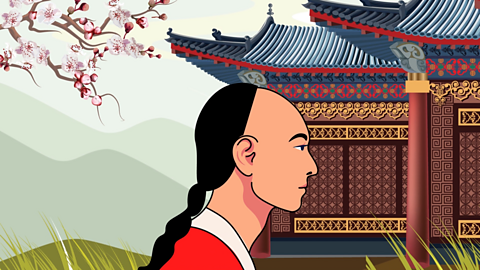Key points
- After the Sorry, something went wrongCheck your connection, refresh the page and try again. completed their takeover of the Ming empire, they didn’t stop expanding.
- Their next wars took them into Central Asia, resulting in the conquest of Outer Mongolia, Sorry, something went wrongCheck your connection, refresh the page and try again. and Tibet.
- In the 1700s, the Qing ruled a vast and prosperous empire.
Activity - Which Qing Emperor are you?
Who were the Qing?
The Qing were the last dynastyA series of rulers who are all from the same family. to rule China.
Founded by the ManchuThe Manchu are a people from northeast China. They conquered China and founded the Qing dynasty. They spoke Manchu., the Qing dynasty defeated the previous MingThe name of the second to last dynasty of China, who ruled the country from 1368-1644. dynasty (1368 - 1644) to become one of China’s most successful dynasties. They ruled from from 1644 to 1911.
From the late 1600s to the early 1800s, the Qing was one of largest, wealthiest, and most sophisticated empires on the planet.
How did the Qing conquer Central Asia?
Although the Qing seized Sorry, something went wrongCheck your connection, refresh the page and try again. in 1644 and had control of much of the old Sorry, something went wrongCheck your connection, refresh the page and try again. empire by the mid-1600s, their conquests did not stop there. The Qing were almost constantly fighting until the mid-1700s. They expanded their rule into Outer Mongolia, Tibet, and XinjiangXinjiang is a province in the far west of China. The north of the province is mountainous and full of grasslands, the south is largely desert..
The expansion of Qing rule was driven partly by a long war with the Dzungar KhanateNomadic Mongol state, 1634-1755, who fought against the Qing., a nomadicNomadic peoples travel from place to place, rather than living in a single place. They often herd animals, such as sheep, yak and horses. MongolThe Mongols are a people from Mongolia. They are often nomadic, which means they travel from place to place rather than settling in a single location. The Mongols were famous for their skill with horses and in warfare. They speak Mongolian and are usually Buddhist. state. Although most Mongol groups submitted to Qing rule, the Sorry, something went wrongCheck your connection, refresh the page and try again. did not.
The Qing defeated the Dzungars in Outer Mongolia in 1698, but the Dzungars remained strong in Xinjiang. They continued to have conflict with the Qing and invaded Tibet in 1717. Control of Tibet and the Dalai LamaSpiritual leader of Tibetan Buddhism. Before the 1950s, the Dalai Lama was also responsible for leading the government of Tibet. was important to the Qing for religious reasons, as TibetanTibetans are people from Tibet, a very high-altitude region of the Himalayas. They speak Tibetan, are often nomadic, and are Buddhist., Mongols and many Sorry, something went wrongCheck your connection, refresh the page and try again. all followed Tibetan Buddhism.
Over 25 years, two Qing emperors sought to finally defeat the Dzungars.
In 1720, the Sorry, something went wrongCheck your connection, refresh the page and try again. Emperor sent soldiers into Tibet, forcing the Dzungars out and taking control.
In 1755, the Sorry, something went wrongCheck your connection, refresh the page and try again. Emperor took advantage of a civil war in the Sorry, something went wrongCheck your connection, refresh the page and try again. and defeated them once and for all. He showed the Dzungars no mercy.
The conquest of Xinjiang was completed in 1759, bringing the desert cities and UyghursUyghurs are Muslims living in the oasis cities of Xinjiang. They speak a language distantly related to Turkish. population of southern Xinjiang into the Qing empire. The Qing had reached its largest extent. They ruled an empire over three times larger than that of the Ming.
The Qianlong Emperor showed no mercy to the Dzungars. What do historians think?
The fall of the Dzungars has been described as one of the first genocides – the deliberate killing of members from a particular group.
Historians debate the extent to which that happened. Some say the emperor was determined they should all be killed; others say that many fled into Russia and Kazakhstan and that many more died of smallpox.
The end of the Dzungars was also the end of the great nomadic steppe empires of Central Asia. These flat grassland empires were good for nomads and their grazing animals. The Qing and Russia, both settled empires, moved into Central Asia, drawing borders and defining frontiers.
How did the Qing emperors control the different groups?
The Qing had different systems of rule for different areas of their empire. They made a distinction between the interior (direct rule), where the HanThe Han are the largest ethnic group in China, and are found across China. They speak Chinese languages and have a range of faiths, including Buddhism, Confucianism and Daoism. lived, and the outer regions (indirect rule), occupied by ManchuThe Manchu are a people from northeast China. They conquered China and founded the Qing dynasty. They spoke Manchu., MongolThe Mongols are a people from Mongolia. They are often nomadic, which means they travel from place to place rather than settling in a single location. The Mongols were famous for their skill with horses and in warfare. They speak Mongolian and are usually Buddhist., Muslims and TibetanTibetans are people from Tibet, a very high-altitude region of the Himalayas. They speak Tibetan, are often nomadic, and are Buddhist..
| Group | Location | Language | Fact |
|---|---|---|---|
| Manchu | North-east China | Manchu | They conquered China and founded the Qing dynasty. |
| Han | China | Chinese | They are the largest ethnic group in China. The previous Ming dynasty emperors were Han. |
| Tibetan | Tibet | Tibetan | They are mostly Buddhist and are often nomadic, although there are also great Tibetan cities. |
| Mongol | Mongolia | Mongolian | They are mostly Buddhist and often nomadic. They are famous for their skill as horse-riding warriors. |
| Muslim | Oasis cities of Xinjiang, north-west China and other cities | Turkic languages, Chinese | Muslim here includes both the Uyghurs and other Muslim groups in Xinjiang and also Chinese-speaking Muslims elsewhere in China. |
How did the Qing govern different regions?
In the old Ming provinces where the Han lived, Qing emperors continued to use the Ming governing system. officialAn official is a person who works for the government. In the Qing, these were mostly men who had passed the Confucian exams and then been appointed to govern local areas – dealing with legal cases, managing town and countryside, and handling the local gods as well. were appointed to govern each area, using laws based on the old Ming laws. Officials were chosen through taking exams that tested their knowledge of ConfucianismConfucianism is a philosophy that demands good behaviour and loyalty to family and emperor. It is based on the teachings of the Chinese philosopher Confucius (551-479 BC), and was at the core of the belief and education systems of most Chinese dynasties. teachings. Passing the exams was vital for anyone who wanted to be important, and Confucian culture valued writers and teachers.
In Xinjiang, Tibet, Mongolia and Manchuria, the Qing governed mostly through leaders from those areas. Local aristocratA person of high social rank who held a hereditary title that gave them authority over others. were given titles and then left to govern with little interference. Their titles were then passed down to their children. Different law codes were drawn up to suit the different cultures of the Mongols, Tibetans, and Uyghurs.
Han were mostly forbidden to move into the outer regions of Tibet, Xinjiang, Mongolia and Manchuria. People from those areas had to apply for permission to travel into the interior.
The idea was that each people had their own space and their own culture. If they each kept to themselves, there would be peace. Disloyalty was always dealt with harshly. For example, the Qianlong Emperor executed authors and their entire families for writing things that criticised the Manchus.
What was taking the government exams like?
Very hard! People were put in an isolated cubicle in a courtyard for three days whilst taking the exam. During that time, they weren’t allowed to go home – they’d even have to sleep there. They would have to answer questions on their knowledge of classical Confucian texts, all of which they had to memorise by heart. They had to write essays as well.
All of this didn’t even guarantee a job. There were three levels of exam and people had to pass all of them to become an official.
How did the Qing emperors celebrate culture?
The emperors of the high Qing – Kangxi, Sorry, something went wrongCheck your connection, refresh the page and try again. and Qianlong – all commissioned great cultural projects. They wanted to show the great learning of the dynasty.
Qianlong tried to celebrate the Manchu, Mongol, Han, Tibetan and Muslim cultures.
- He commissioned a five-language dictionary to translate Manchu, Mongol, Chinese, Tibetan and ChagataiAn extinct language that was used in literature in Central Asia..
- He had Tibetan Buddhist texts and Chinese classics translated into Manchu.
- He organised the greatest collection of Chinese books ever made, resulting in the Sorry, something went wrongCheck your connection, refresh the page and try again. – a collection of 3952 Chinese works.
- He had a mosque built in Beijing, facing the Forbidden City, and invited Tibetan monks to the city.
- His hunting lodge at Sorry, something went wrongCheck your connection, refresh the page and try again. had a pagodaA tiered tower, common in the East Asia. They were often built as temples or memorials. and lakes to look like a Chinese landscape, next to buildings made to look like Tibetan monasteryBuildings lived in by a community of monks who live under religious vows. and Mongolian-style yurtA circular tent made from skins or felt, used by Mongolian nomads..
Famous Qing emperors
Nurhaci

Sorry, something went wrongCheck your connection, refresh the page and try again. (1559 - 1626) was the Manchu chieftain who founded the dynasty, although he did not rule as Emperor of China himself.
As a child, Nurhaci was captured by Ming commander Sorry, something went wrongCheck your connection, refresh the page and try again., and brought up in his household. Li continued to support Nurhaci after Nurhaci had left Li's household. After Nurhaci's father and grandfather were killed by another force fighting for the Ming, Nurhaci resolved to unite the Manchu tribes and, ultimately, to conquer China.
Nurhaci spent much of his life fighting, and he was also clearly an ambitious and clever thinker. He ordered the creation of a script for the Manchu language, and the Eight Banner structure he created for the Manchu armies came to define Manchu society.
The Kangxi Emperor
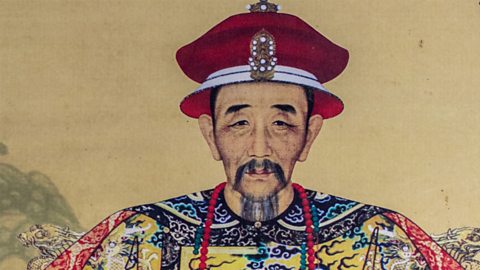
The Kangxi Emperor (1654 - 1722) was the longest-reigning emperor in Chinese history. He came to the throne at the age of just seven, after the Sorry, something went wrongCheck your connection, refresh the page and try again. Emperor died of smallpox. At first, a council of regents ruled on his behalf. However, when he was 15, the Kangxi Emperor had them arrested with the help of his grandmother and began to rule in his own right.
Kangxi was a strong military leader and spent much of his reign fighting to put down rebellions and conquer the remaining districts of China. However, he was also a good peacetime ruler, reducing taxes and helping make the areas he governed wealthy.
Kangxi was very experienced in the Chinese classics and commissioned a new Chinese dictionary. The Kangxi Dictionary is still important today. He was interested in all kinds of technology and welcomed Jesuits to his court for their knowledge of mapmaking, painting and medicine. Jesuits are members of the Roman Catholic Society of Jesus.
The Yongzheng Emperor
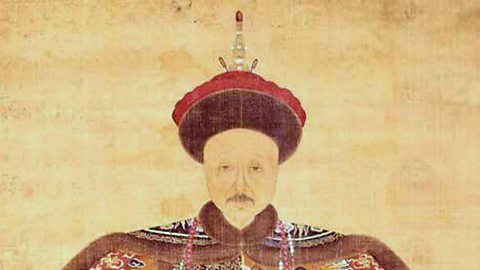
The Sorry, something went wrongCheck your connection, refresh the page and try again. Emperor (1678 - 1735) was the fourth emperor of the Qing and is known for being hardworking - he is said to have worked himself to death!
Yongzheng's father the Kangxi Emperor did not clearly designate a successor, and there was much competition among the princes as to who would become the next emperor. After Yongzheng became emperor, he still worried his brothers would plot against him - so he imprisoned some and sent others away. Yongzheng later took measures to make sure it was clear who would become ruler after his death, to prevent his children from fighting.
Yongzheng was a very effective emperor and he worked hard to maintain peace and wealth. He made changes to government to improve communications and to make sure he always knew what was happening.
The Qianlong Emperor
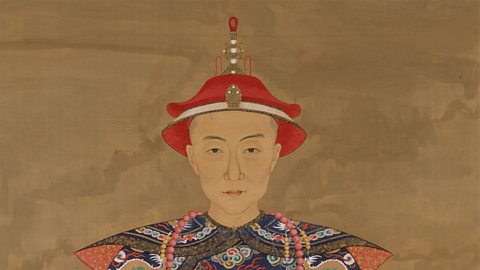
The Qianlong Emperor (1711 - 1799) was also one of the longest-reigning emperors in Chinese history. Under his rule, the Qing empire expanded to its greatest extent and Qianlong was proud of his many battle victories. Qianlong seems to have thought of himself as a universal ruler, ruling over many different peoples with no limit to his authority.
Qianlong was a very cultured ruler: he wrote lots of poetry and liked to collect art. He sponsored many cultural projects in his empire. He was deeply interested in Buddhism.
Qianlong was the only emperor ever to retire. He did not wish to reign longer than his grandfather the Kangxi Emperor, as he thought this would be disrespectful. He abdicated in favour of his son, the Sorry, something went wrongCheck your connection, refresh the page and try again. Emperor.
Cixi
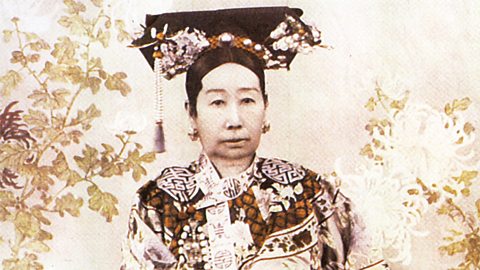
Sorry, something went wrongCheck your connection, refresh the page and try again. (1835 - 1908) never ruled in her own name. However, she was in effect the highest ruler in the Qing from 1861 onwards when her young son was made emperor and she became regent. This meant that she ruled on behalf of her young son. She was ambitious and determined and dominated a very challenging period of Chinese history.
As a woman, she could not rule openly but instead directed the government from 'behind the curtain'. There are lots of rumours that she poisoned challengers to stay in power, although historians have found little evidence that she did.
Cixi is also known for loving her dogs and the opera. She is infamous for the money she spent having the Old Summer Palace rebuilt at a time when the empire was struggling.
Peace and Power
At its height, the Qing was one of the richest empires in the world. Peace had brought great wealth. The introduction of new foods, such as potatoes, tomatoes, and chilli peppers, allowed more land to be farmed. The new foods, irrigationA man-made water supply to water crops. works and swift government action against natural disasters allowed the population to expand rapidly during the 1700s.
Literacy and living standards were high. Chinese goods were sold across the world and were celebrated for their beauty and advanced manufacturing.
When Lord Macartney, a British diplomat and statesman, arrived in China in 1793, he came with a mission to expand access to China and open up trade for the British. He met the Qianlong Emperor – but the Qianlong Emperor rejected his offer. As the Qianlong Emperor saw it, Britain had nothing his empire would need. China already had everything.
Test your knowledge
Play the History Detectives game! gamePlay the History Detectives game!
Analyse and evaluate evidence to uncover some of history’s burning questions in this game.

More on The Qing dynasty (1644-1911)
Find out more by working through a topic
- count3 of 3

- count1 of 3
